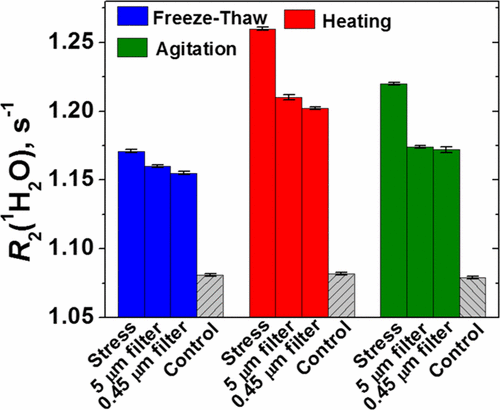当前位置:
X-MOL 学术
›
Anal. Chem.
›
论文详情
Our official English website, www.x-mol.net, welcomes your
feedback! (Note: you will need to create a separate account there.)
Water Proton NMR: A Tool for Protein Aggregation Characterization
Analytical Chemistry ( IF 6.7 ) Pub Date : 2017-05-03 00:00:00 , DOI: 10.1021/acs.analchem.7b00464
Marc B. Taraban 1 , Roberto A. DePaz 2 , Brian Lobo 2 , Y. Bruce Yu 1
Analytical Chemistry ( IF 6.7 ) Pub Date : 2017-05-03 00:00:00 , DOI: 10.1021/acs.analchem.7b00464
Marc B. Taraban 1 , Roberto A. DePaz 2 , Brian Lobo 2 , Y. Bruce Yu 1
Affiliation

|
Formulation stability is a critical attribute of any protein-based biopharmaceutical drug due to a protein’s inherent tendency to aggregate. Advanced analytical techniques currently used for characterization of protein aggregates are prone to a number of limitations and usually require additional manipulations with the sample, such as dilution, separation, labeling, and use of special cuvettes. In the present work, we compared conventional techniques for the analysis of protein aggregates with a novel approach that employs the water proton transverse relaxation rate R2(1H2O). We explored differences in the sensitivity of conventional techniques, size-exclusion chromatography (SEC), microflow imaging (MFI), and dynamic light scattering (DLS), and water NMR (wNMR) toward the presence of monoclonal antibody aggregates generated by different stresses. We demonstrate that wNMR outperformed SEC, DLS, and MFI in that it was most consistently sensitive to increases in both soluble and insoluble aggregates, including subvisible particles. The simplicity of wNMR, its sensitivity, and possibility of noninvasive measurements are unique advantages that would permit its application for more efficient and higher throughput optimization of protein formulations.
中文翻译:

水质子NMR:蛋白质聚集表征的工具
由于蛋白质固有的聚集趋势,制剂稳定性是任何基于蛋白质的生物药物的关键属性。当前用于表征蛋白质聚集体的高级分析技术容易受到许多限制,并且通常需要对样品进行其他操作,例如稀释,分离,标记和使用特殊比色皿。在目前的工作中,我们将传统的蛋白质聚集体分析技术与采用水质子横向弛豫率R 2(1 H 2)的新方法进行了比较。O)。我们探讨了常规技术,尺寸排阻色谱法(SEC),微流成像(MFI)和动态光散射(DLS)和水NMR(w NMR)对存在不同应力产生的单克隆抗体聚集体的敏感性的差异。 。我们证明w NMR优于SEC,DLS和MFI,因为它对可溶和不可溶聚集体(包括亚可见颗粒)的增加最一致地敏感。的简单瓦特NMR,其灵敏度,以及非侵入式测量的可能性是独特的优点将允许更有效和吞吐量蛋白质制剂的优化更高及其应用。
更新日期:2017-05-03
中文翻译:

水质子NMR:蛋白质聚集表征的工具
由于蛋白质固有的聚集趋势,制剂稳定性是任何基于蛋白质的生物药物的关键属性。当前用于表征蛋白质聚集体的高级分析技术容易受到许多限制,并且通常需要对样品进行其他操作,例如稀释,分离,标记和使用特殊比色皿。在目前的工作中,我们将传统的蛋白质聚集体分析技术与采用水质子横向弛豫率R 2(1 H 2)的新方法进行了比较。O)。我们探讨了常规技术,尺寸排阻色谱法(SEC),微流成像(MFI)和动态光散射(DLS)和水NMR(w NMR)对存在不同应力产生的单克隆抗体聚集体的敏感性的差异。 。我们证明w NMR优于SEC,DLS和MFI,因为它对可溶和不可溶聚集体(包括亚可见颗粒)的增加最一致地敏感。的简单瓦特NMR,其灵敏度,以及非侵入式测量的可能性是独特的优点将允许更有效和吞吐量蛋白质制剂的优化更高及其应用。



































 京公网安备 11010802027423号
京公网安备 11010802027423号